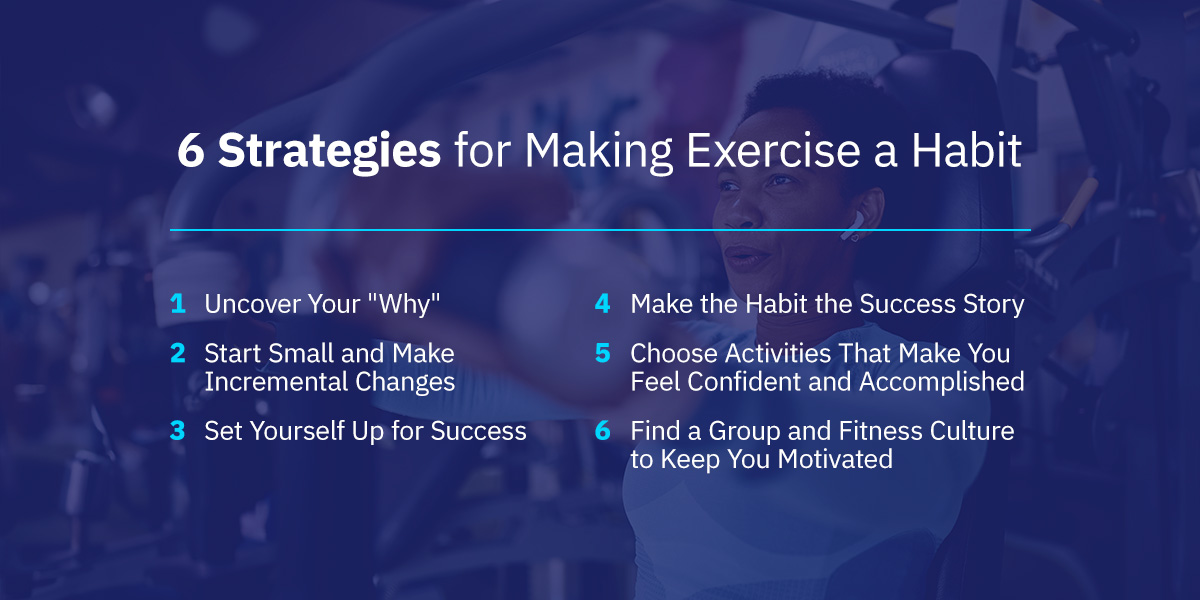How to Make Exercising a Habit
How to Make Exercising a Habit
Posted on: June 18, 2024 in BeginnersWhen you’re new to exercise, it’s easy to start and challenging to maintain. Many people hit the ground running, excited for their new fitness journey. A few months later, check in with those same people, and most have slipped back into old habits. The trick to seeing it through is knowing how to make exercise a habit.
Why Is a Lasting Exercise Habit Important?
Physical activity is one of the most essential ingredients for living a long, healthy life. It’s linked with managing several diseases, including cancer and mood disorders. From your first workout, you experience immediate benefits, which compound in the long term. Although every exercise session has benefits, developing an exercise habit can be life-changing, helping you manage your weight, reducing the risk of heart attacks and strengthening your muscles and bones.
Exercise also releases endorphins, which are a natural happiness and energy boost. Habitual exercise can also alleviate depression and anxiety, help you cope with stress and improve your self-esteem and cognitive functions. When you know how to make working out a habit, you feel more capable in your daily life.
Why Is It Challenging to Form Fitness Habits?
We all know about the benefits of regular exercise, yet many of us still struggle to make it a habit. Several theories exist to explain why so many people find it challenging, some of which include:
- Finding time: With so much going on, there doesn’t seem to be time to fit exercise into our daily lives. It’s also easy to procrastinate if you’re tired or have had a long day.
- Having unrealistic expectations: Many people begin their exercise journeys expecting to see quick results and have fun every time. In truth, exercise habits should persist regardless of whether we’re in the mood or see any significant changes in body composition. We often start strong but become bored or demoralized when we don’t see the expected results.
- Falling back on previous habits: Once something is a habit, whether it’s good or bad, it’s challenging to break. While creating new habits, it’s easy to fall back on the old ones. For example, if a previous habit was to stay in bed for an extra half hour every morning and drink coffee, it could be easy to fall back into that pattern on cold or windy days.
- Giving in to perfectionism: “All or nothing thinking” can be a significant challenge. We set a goal to exercise daily, and if we miss even one workout, we’ve failed. This thinking is demoralizing and quickly paves the way back into a sedentary lifestyle.
6 Strategies for Making Exercise a Habit
Patience is one of your most important assets as you embark on this exciting new journey. No matter your past challenges, the following tips and tricks can help you create an exercise habit you can stick to and enjoy a healthy and fulfilling life.
1. Uncover Your “Why”
You need a convincing reason to maintain a habit — one powerful enough to override your procrastination. Think about why you want to develop a consistent exercise habit.
Once you have your overarching reason for working out, you can consider creating achievable short — and long-term goals. Start with your long-term goals and work from there. Becoming too ambitious with your long-term goals is a common setback, so stick to specific, measurable, achievable, realistic and timely (SMART) goals that will motivate you to keep going.
Once you know what you want to achieve in the long term, you can set short-term goals, which act as a road map to help you get there. These goals should be specific and purposeful, such as attending a fitness class once a week. As you achieve one short-term goal and get closer to your long-term objective, you can cross it off and replace it with a new one — a powerful way to keep yourself motivated to work out.
2. Start Small and Make Incremental Changes
Exercise is supposed to make you feel good. Making significant changes too quickly can have the opposite effect. It’s best to find your feet slowly, easing into any new exercise program and celebrating the small wins. Think about minor changes you can make to your current routine and stick with them. They’ll compound, and you’ll see a significant difference over time.
Consider how you can make exercises easy and consistent. If an hour-long gym session seems too challenging, focus on 10 minutes and consider that a win. Start with small workouts with attainable goals so every session feels like a win.
3. Set Yourself Up for Success
One of the most critical elements of creating lifelong habits is to remove as much friction as possible. Try to make exercise part of your routine by committing to the same time every day. You can also put triggers around your home to remind you, like laying your workout gear the night before and putting your gym’s class calendar on the fridge.
Develop an exercise ritual to make starting easier. For example, start your morning with a big glass of water, play upbeat music and head to the gym. If you do these things every time, your ritual will become a habit.
4. Make the Habit the Success Story
If you make the habit your first goal instead of the results, you have a better chance of making it last. Establishing your new routine is your primary goal in the beginning. Focus on that, even if it’s at the expense of your physical results.
Your first move could be as non-physical as taking out a gym membership and entering the building daily until it feels routine. You can focus on the results once your system feels part of your daily routine.
5. Choose Activities That Make You Feel Confident and Accomplished
In the early stages of your exercise journey, try as many activities as possible until you find one that excites you. When you love an activity, it’s much easier to maintain, as you see it as something you get to do, not something you have to do.
At the end of every workout, you should feel as though you’ve accomplished something, however small. After a while, you’ll start seeking positive reinforcements, even when you don’t feel like exercising.
6. Find a Group and Fitness Culture to Keep You Motivated
Social support is one of the most critical elements in creating new habits. It has been shown to help new gym goers stick to their fitness habits. Joining a gym gives you immediate access to a social group with the same goals and challenges as you, providing a built-in support system. Think about what you want most from your new fitness habit and find a gym that meets those needs.
Joining a gym motivates you and inspires you to work harder during sessions. Over time, you build social connections that make exercise more fun and help you hold yourself accountable. You also have various classes, making experimenting easy until you find something you love. Access to professionals, equipment and facilities can also accelerate your fitness journey so you can see the results that keep you motivated.
Stick to Your New Exercise Habit With 5 Bridges Health and Fitness
When discovering your new routine and laying the foundation for life-long habits, having a team of professionals by your side can mean the difference between success and starting from scratch. At 5 Bridges Health and Fitness, we take a holistic approach to your overall well-being, giving you the tools to create and maintain lasting fitness habits.
Our approach differs from other health clubs by focusing on more than just the fitness component. Our total health approach covers nutrition, recovery and fitness, giving you access to certified professionals in various wellness fields and a solid approach to your new habits. Our personal trainers work with you one-on-one to achieve your fitness goals, starting with a fitness consultation and determining the best path for your unique journey. Sign up for a free trial and start building lasting exercise habits today!






